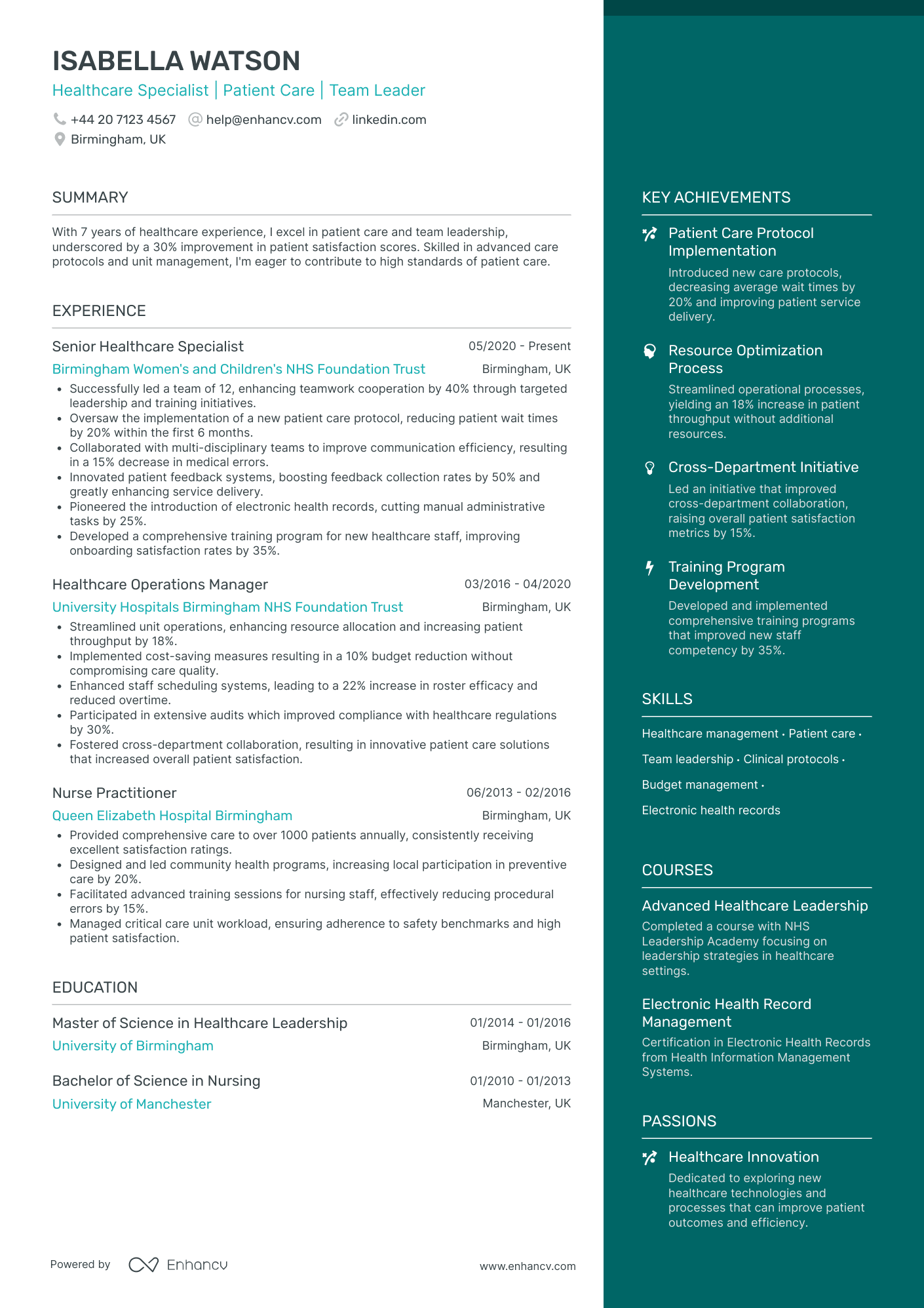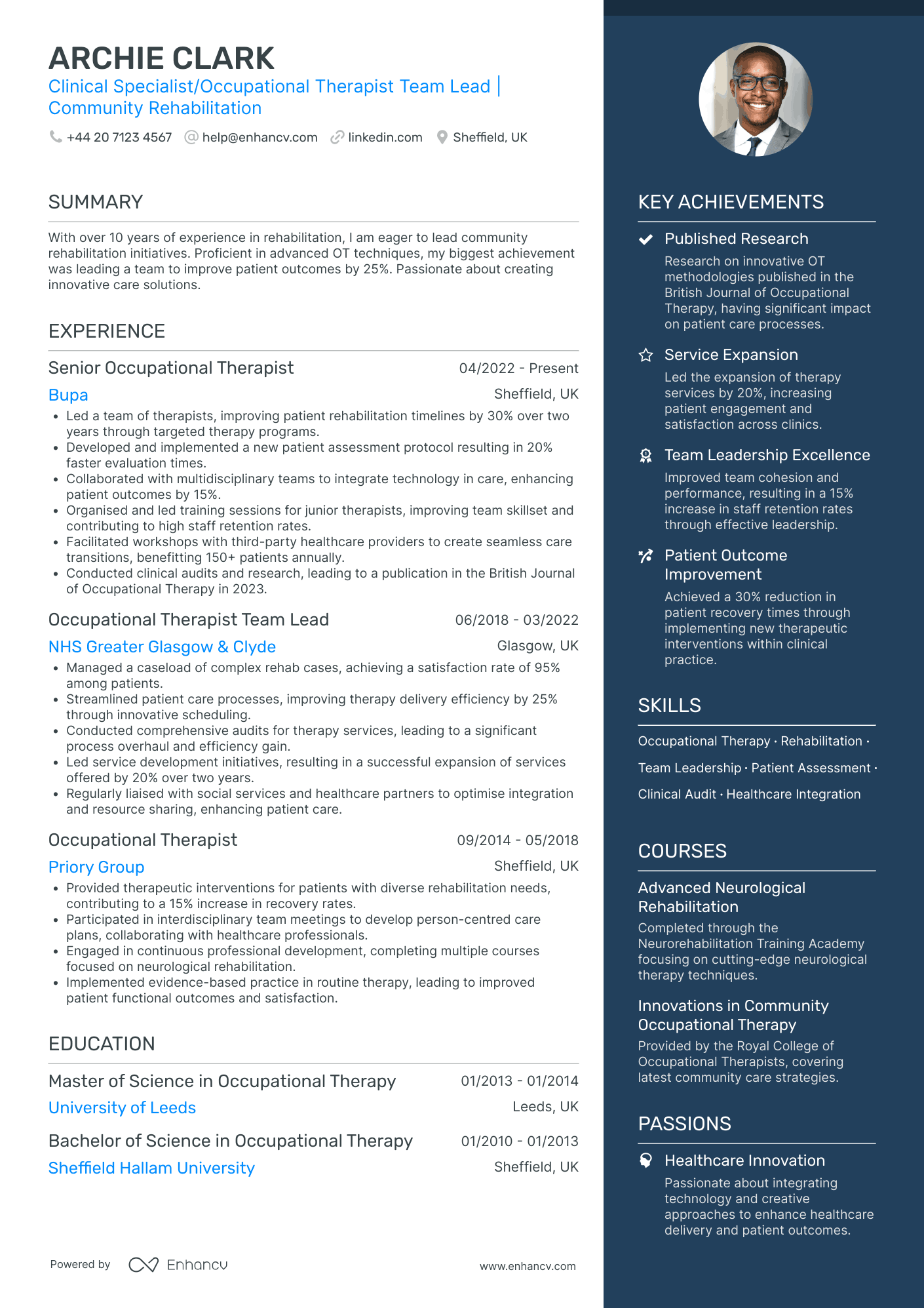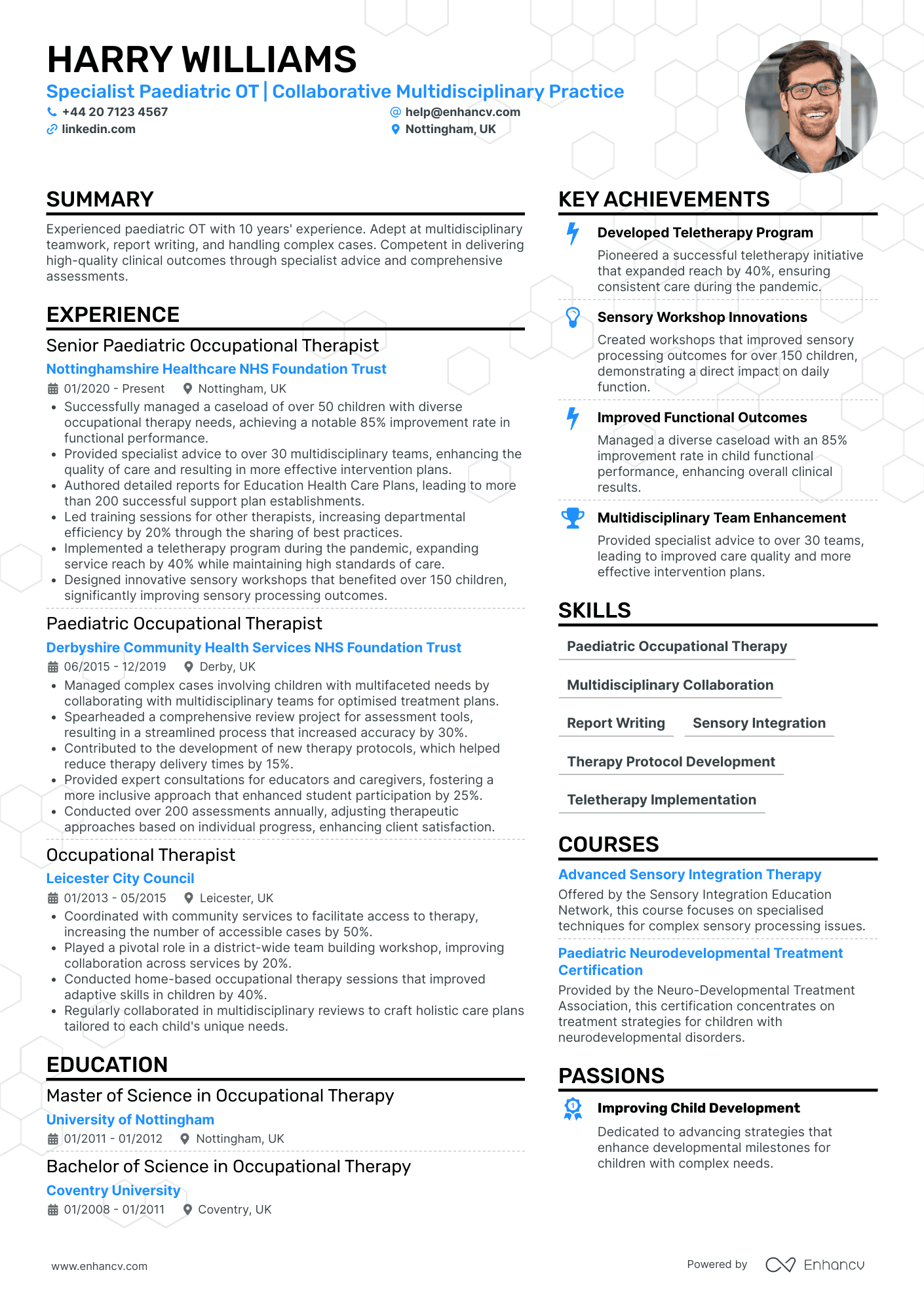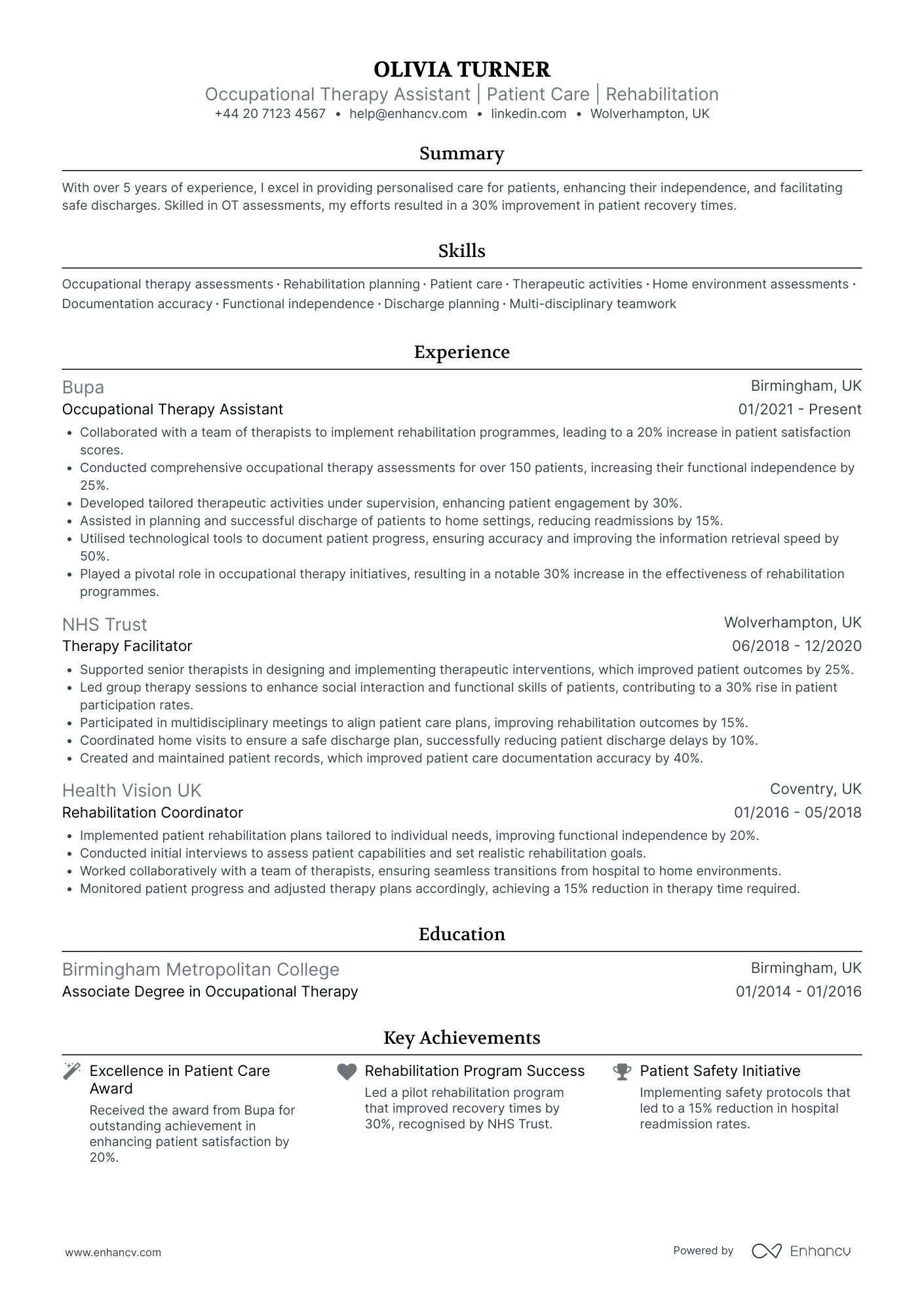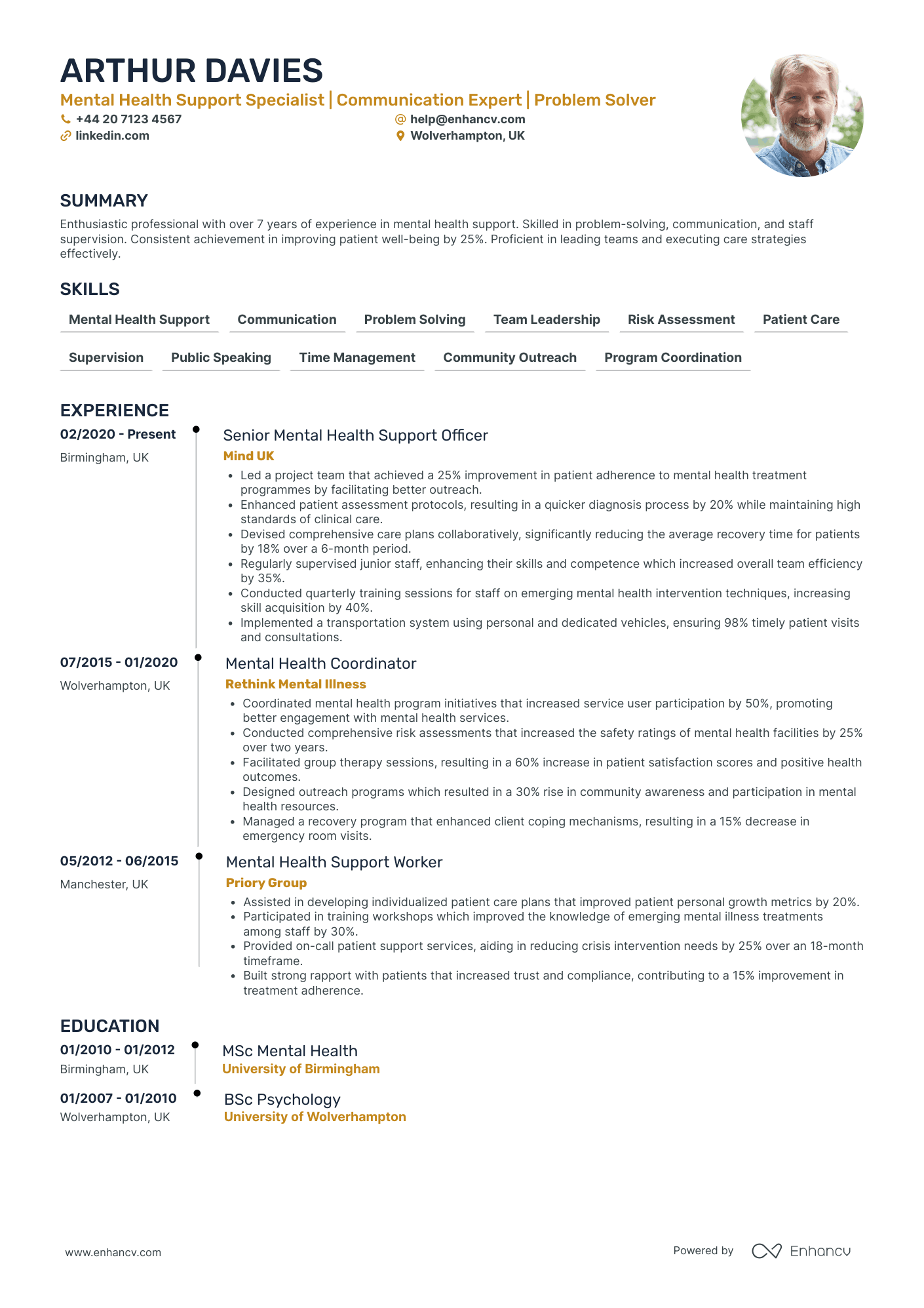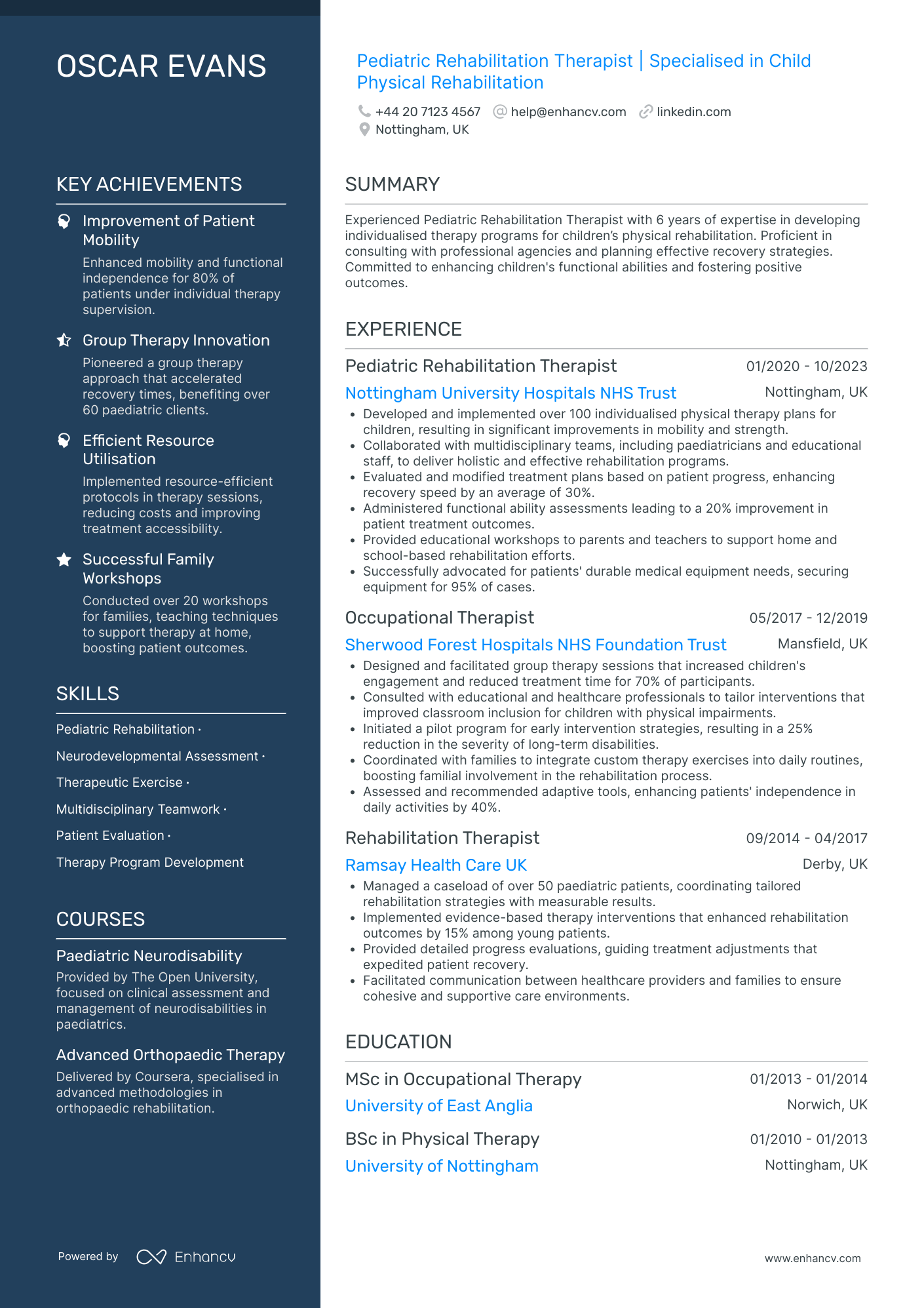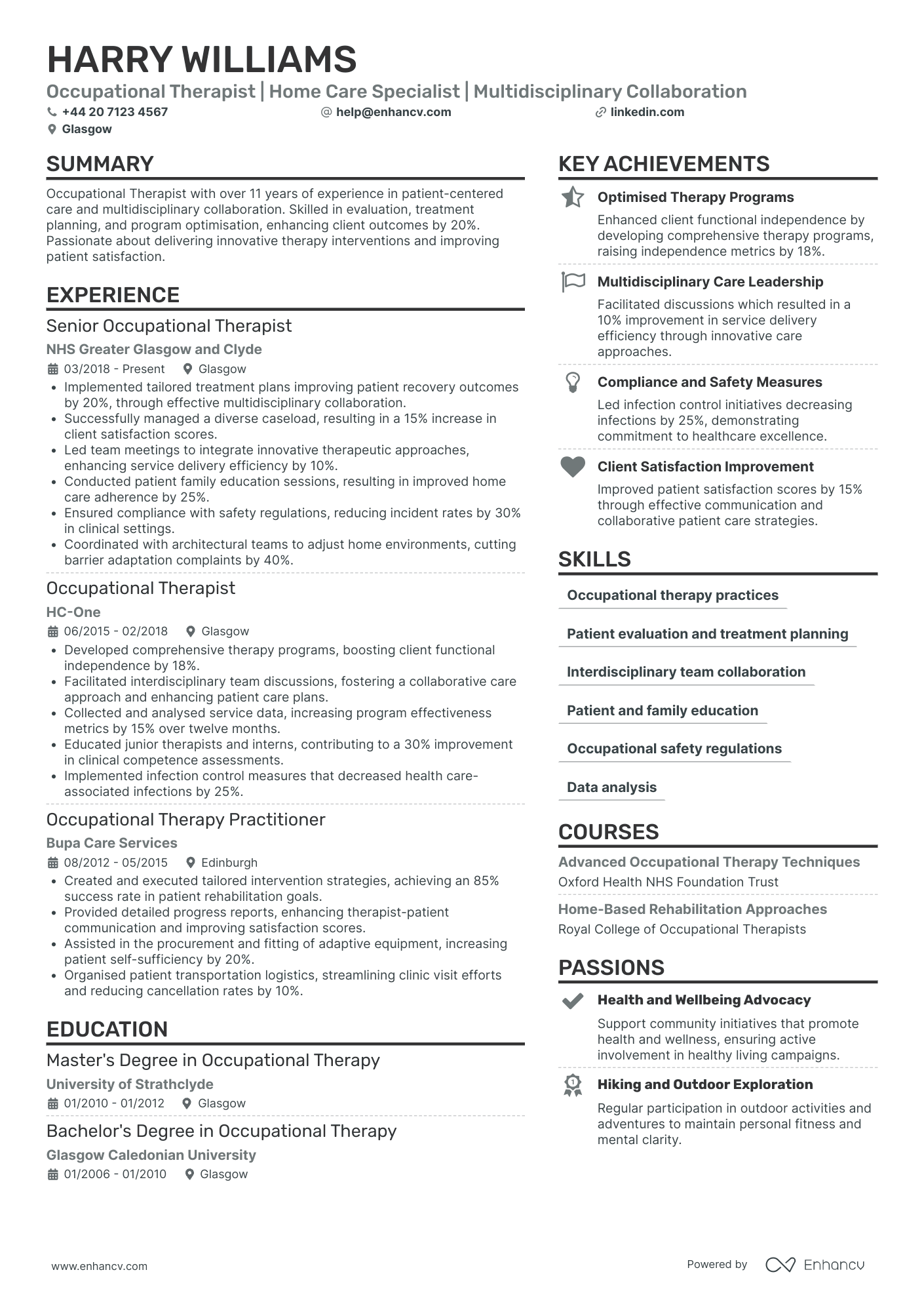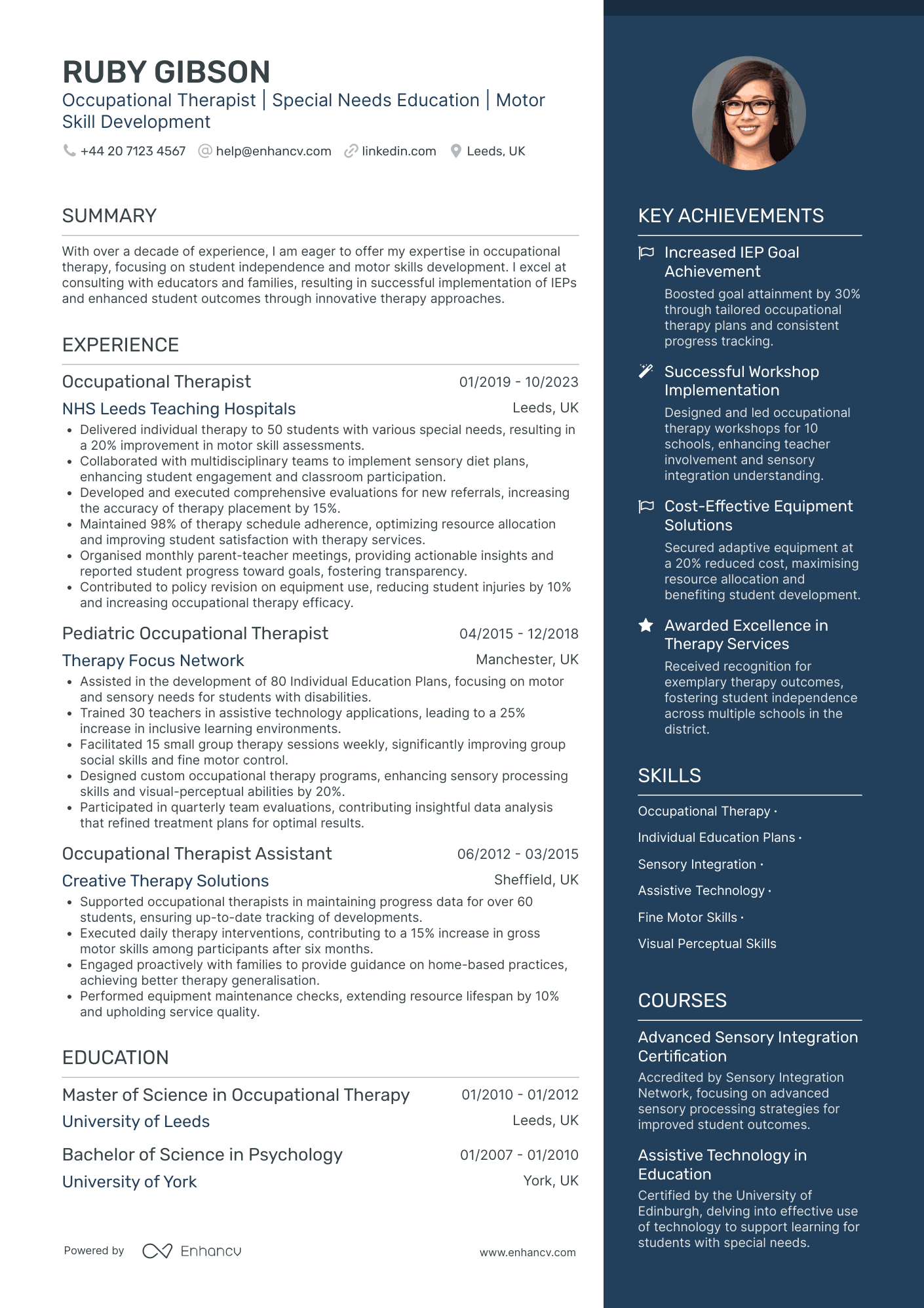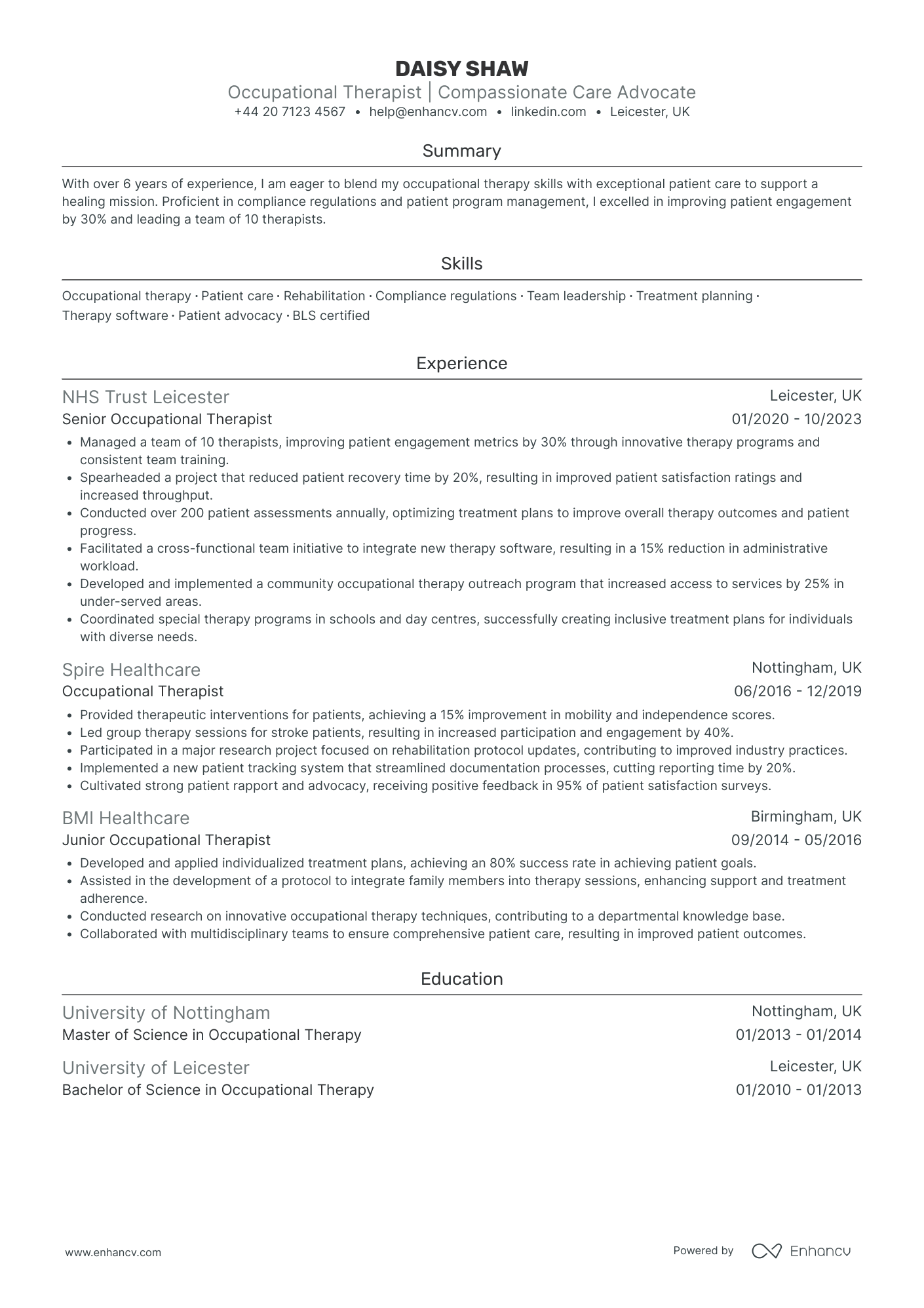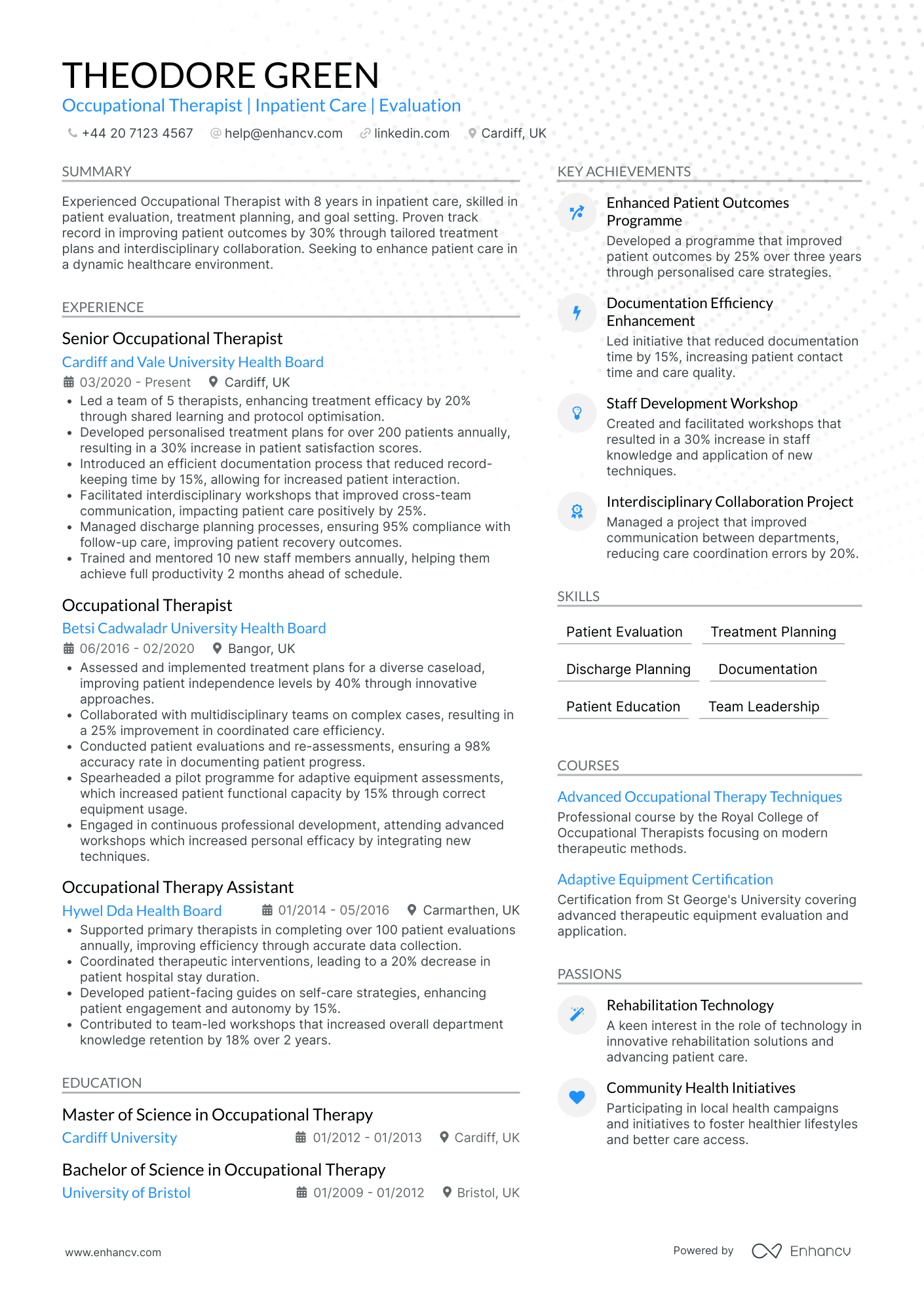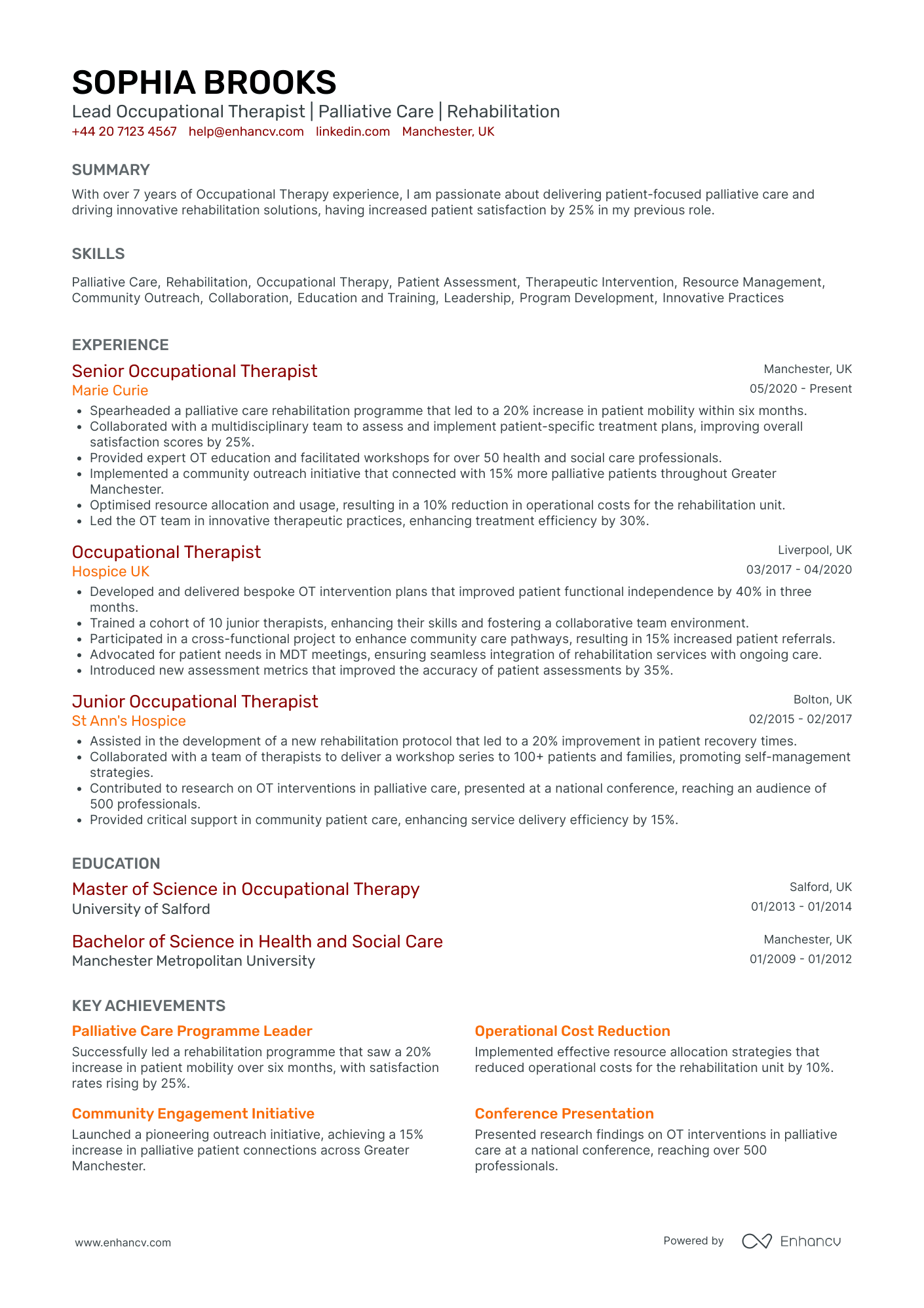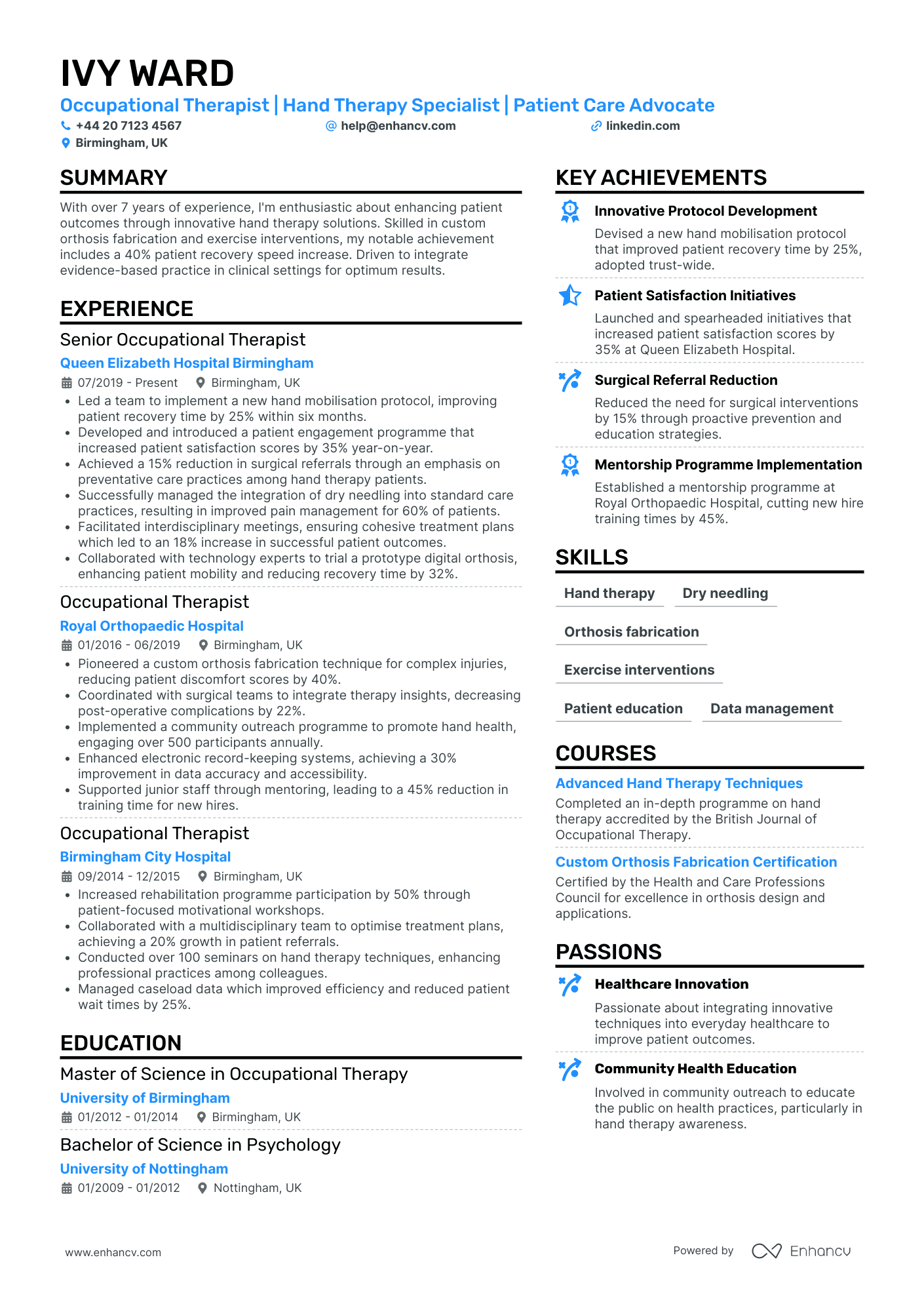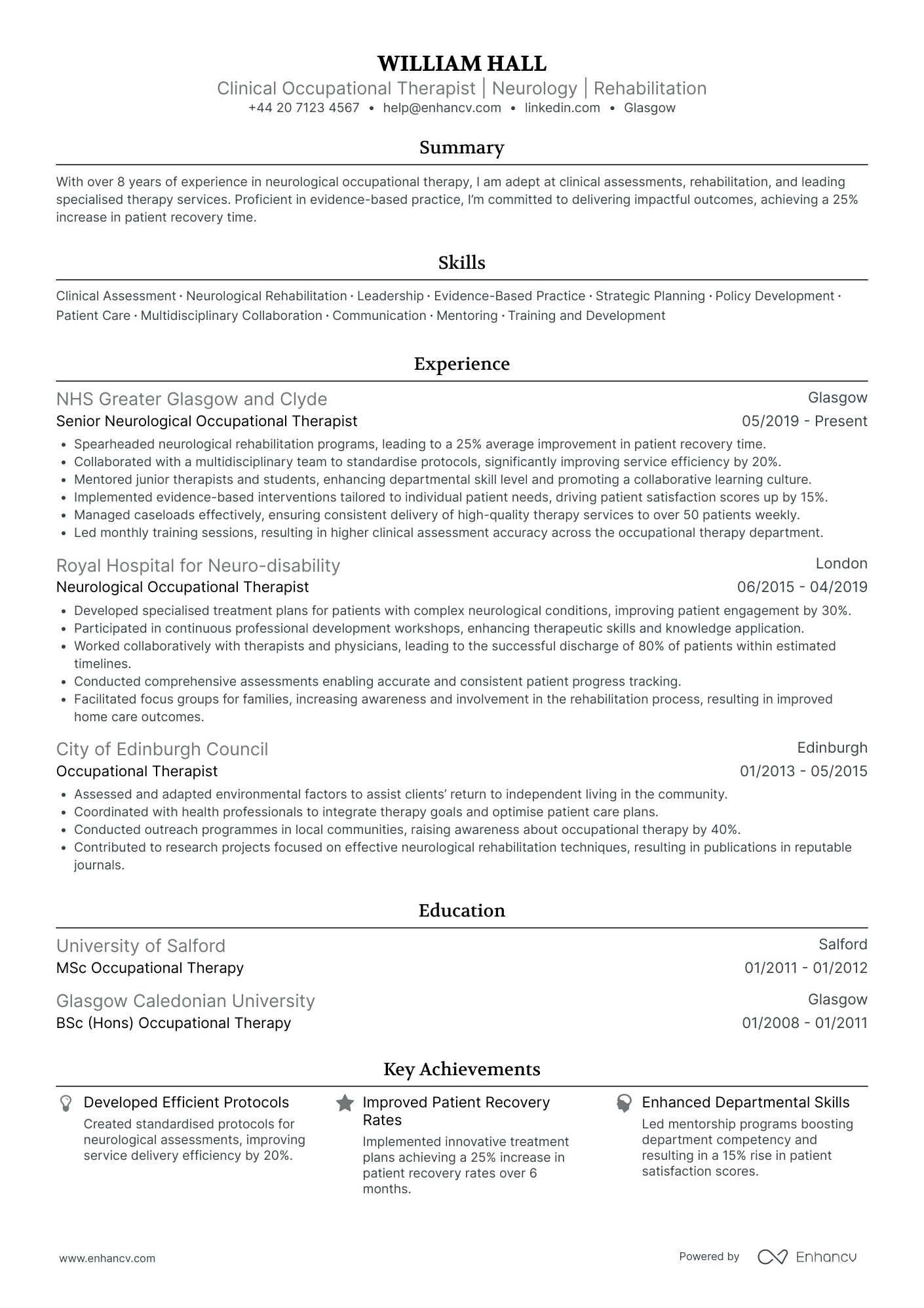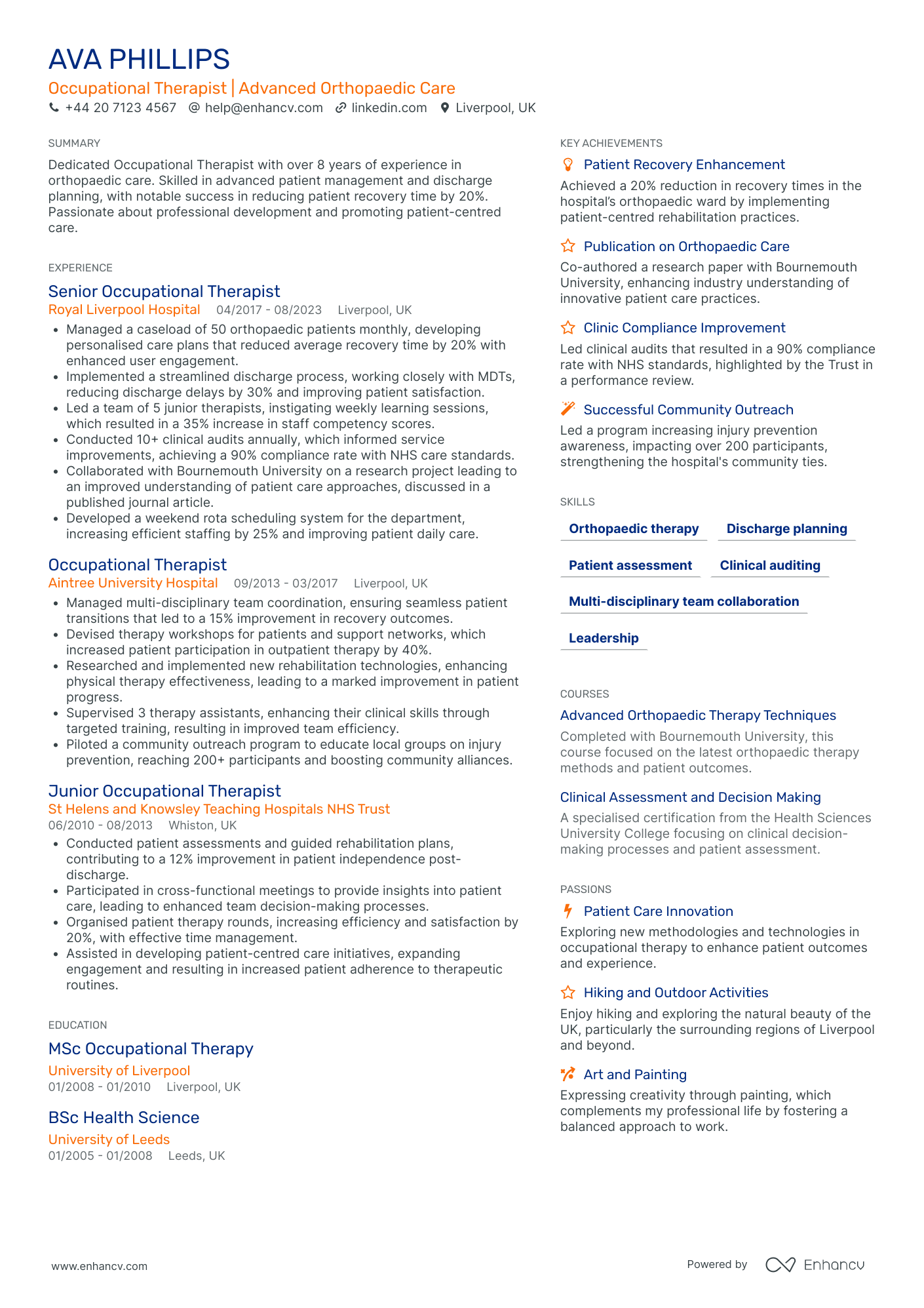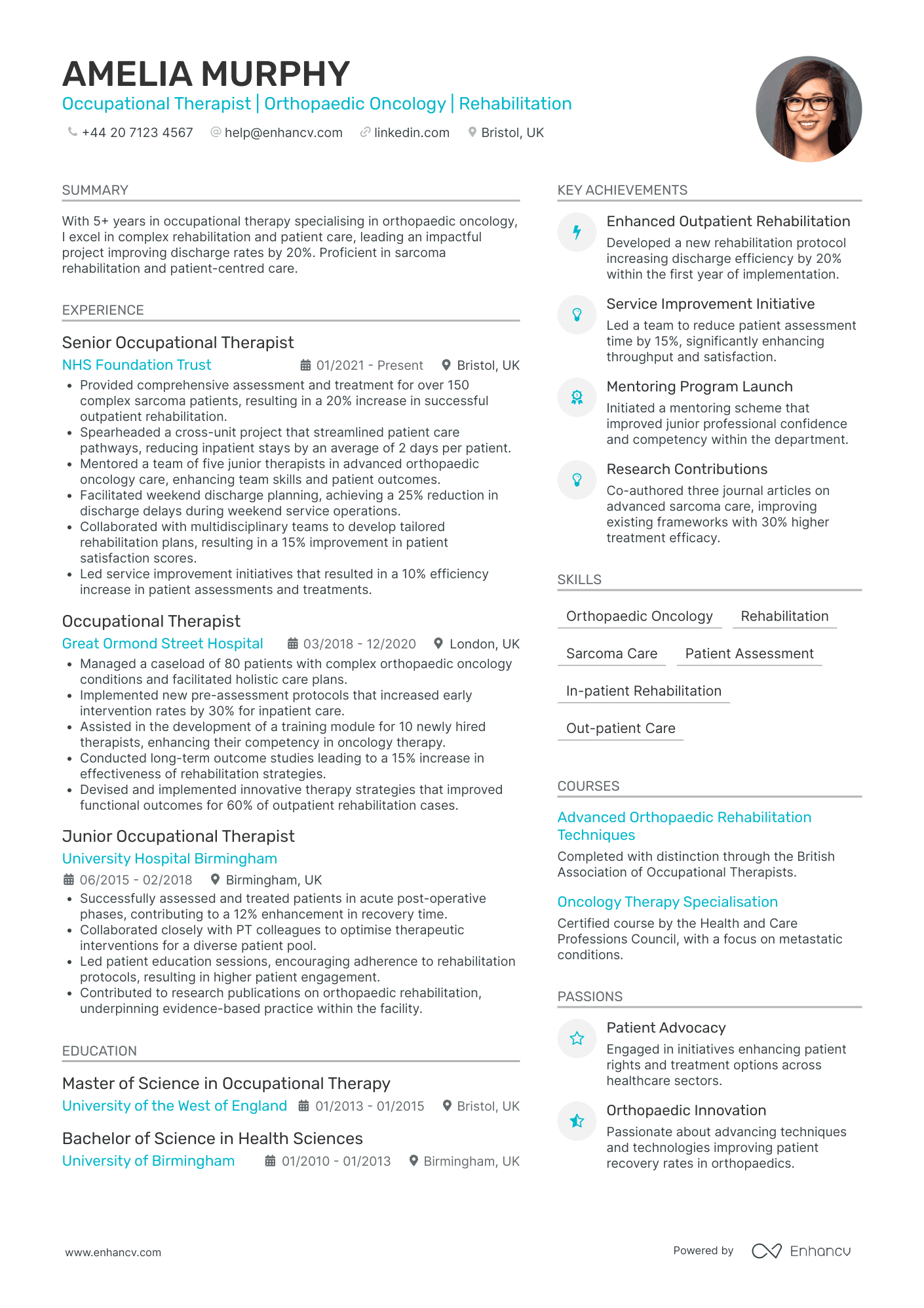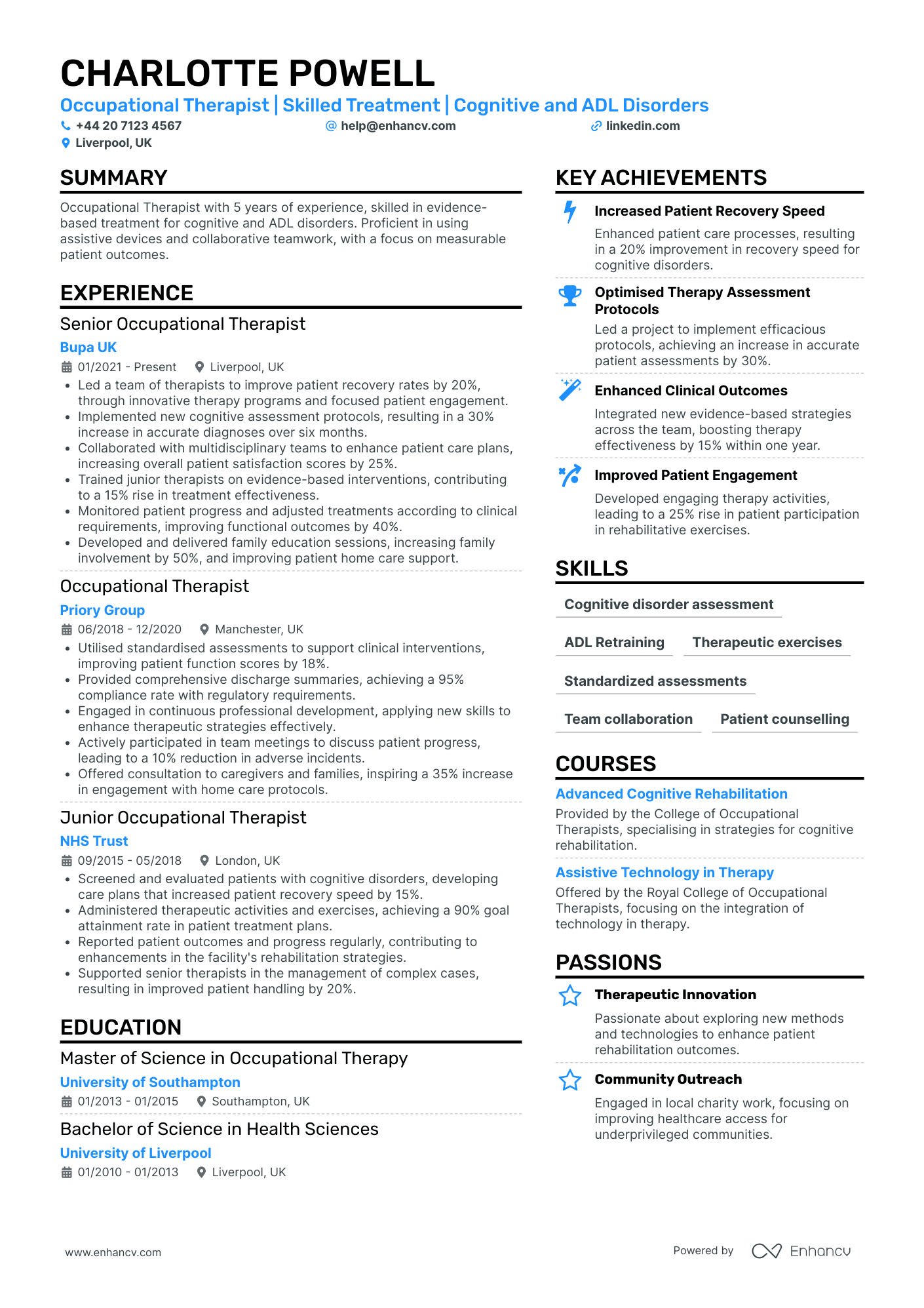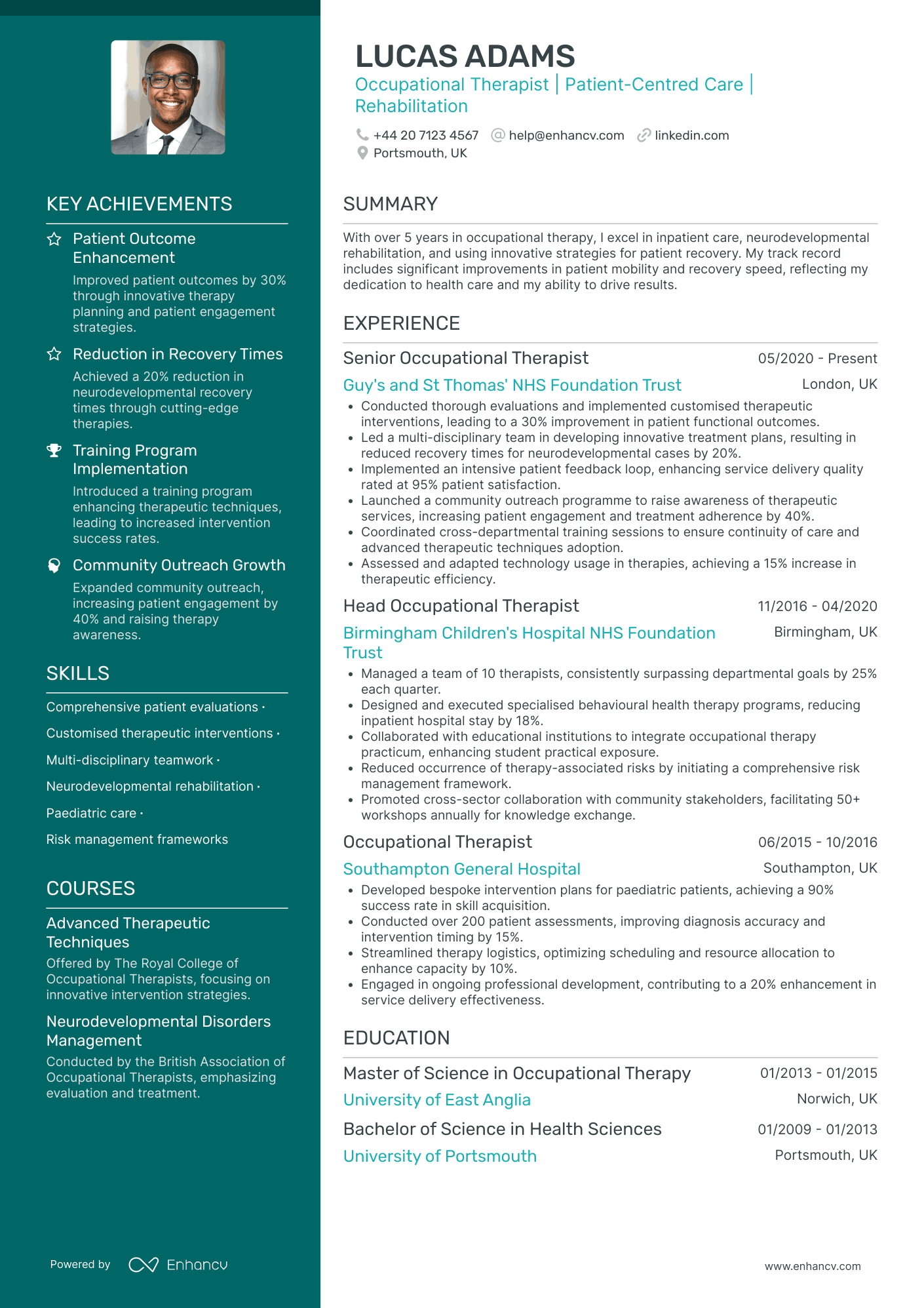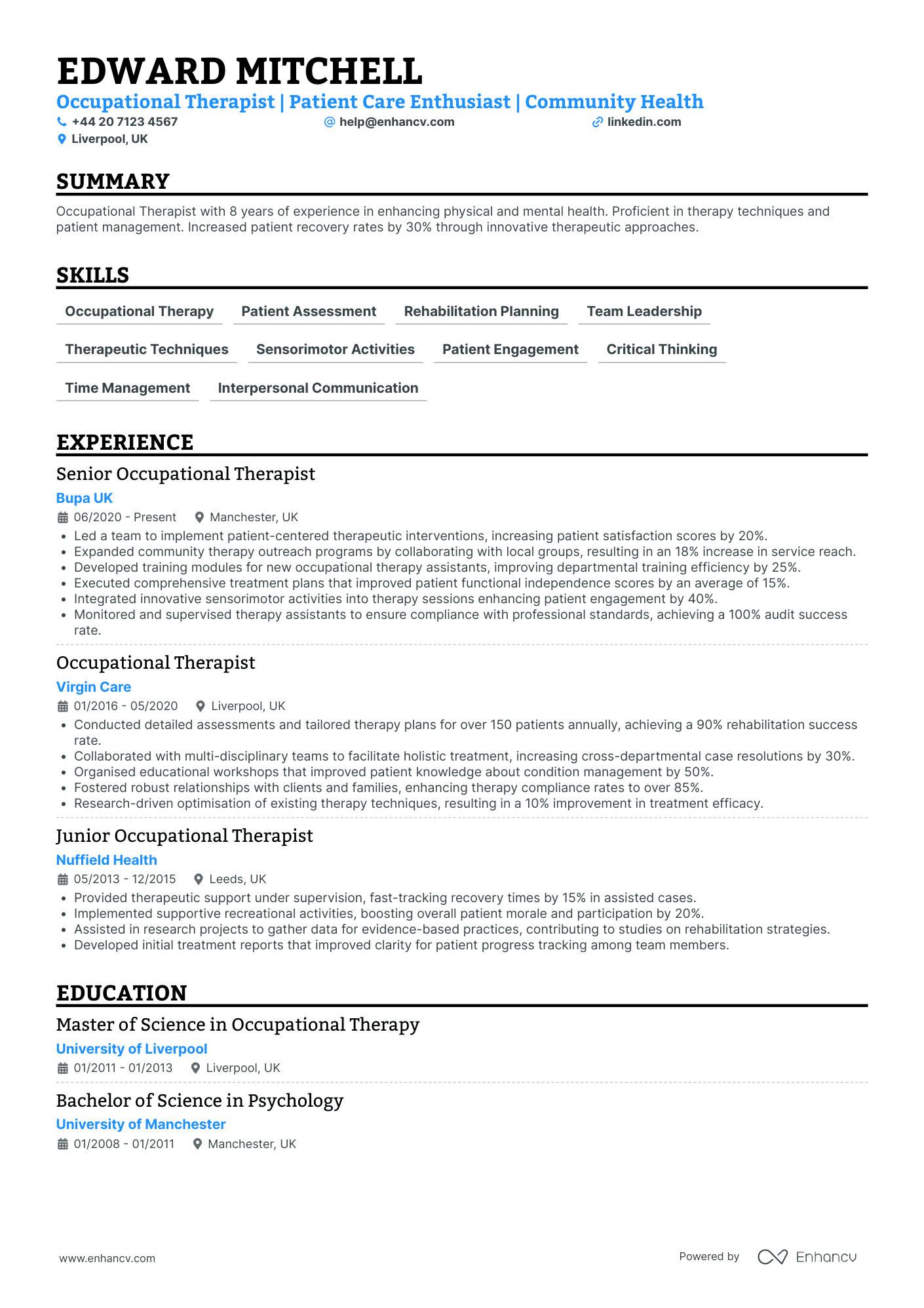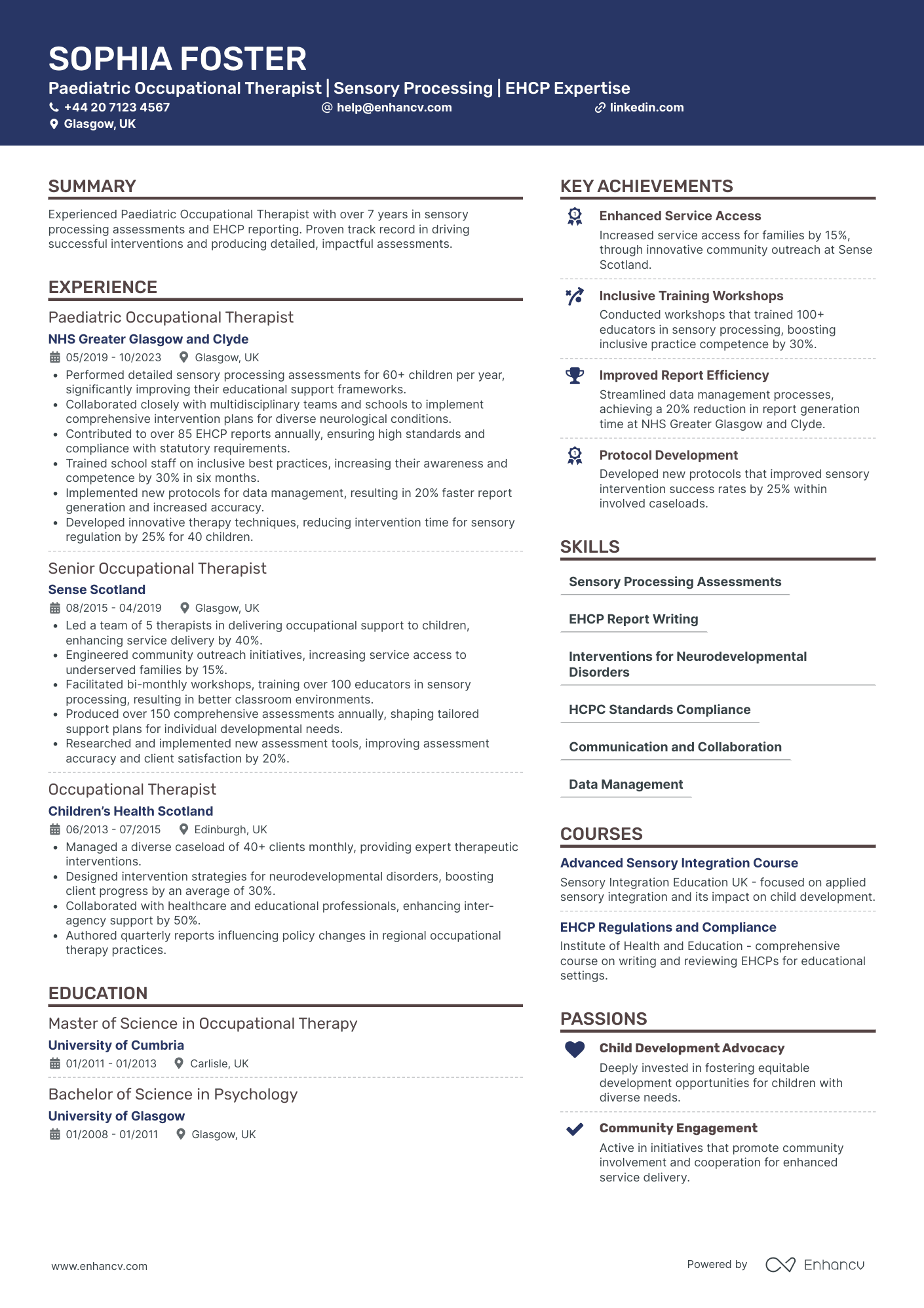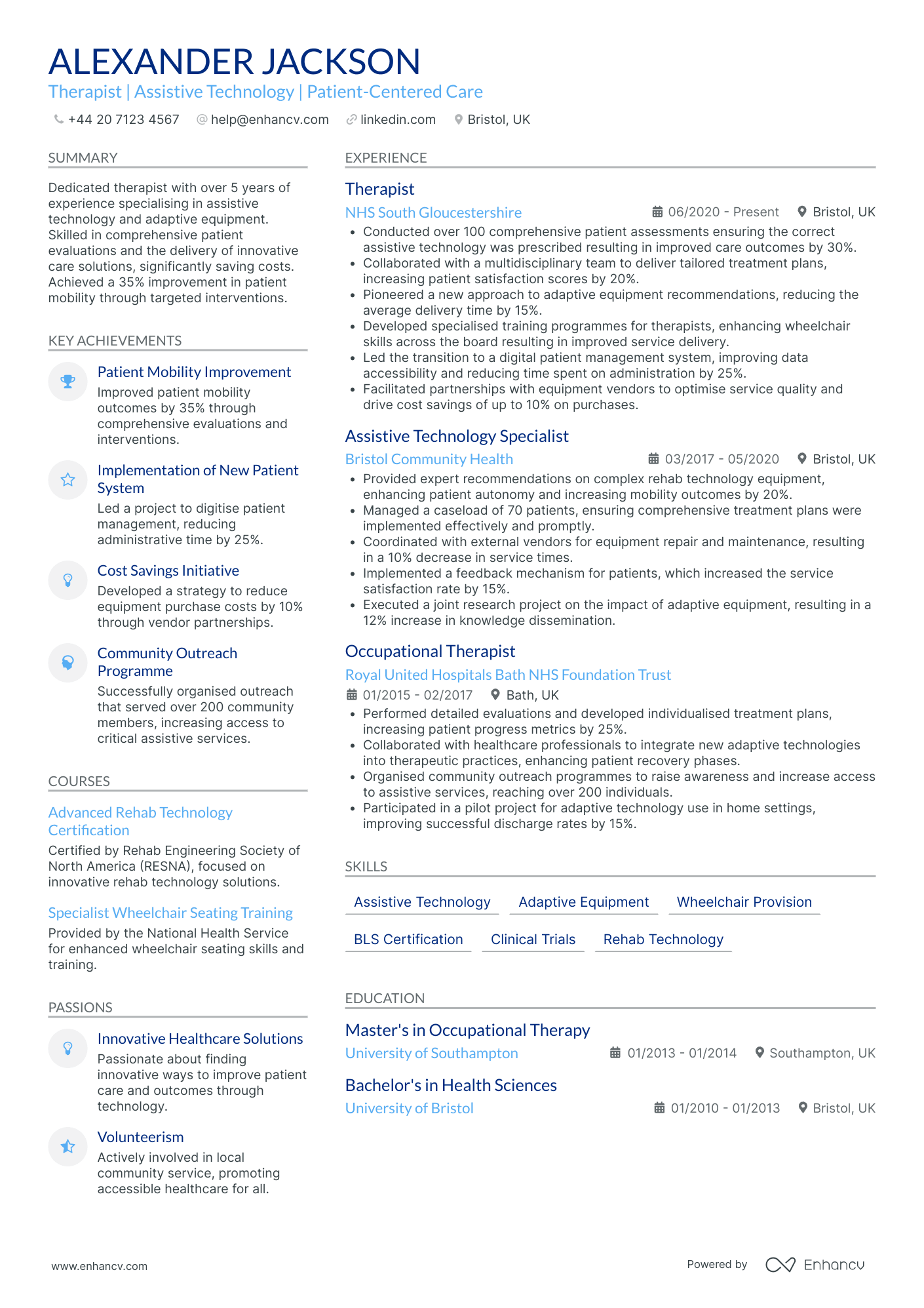Crafting a CV that effectively showcases the diverse range of skills and experiences you've gained as an occupational therapist can be a daunting task. Our guide provides tailored advice to help you highlight your unique qualifications and clinical expertise, ensuring your CV stands out to potential employers.
- Applying the simplest CV design, so that recruiters can easily understand your expertise, skills, and professional background;
- Ensuring you stand out with your header, summary or objective statement, and a designated skills section;
- Creating your CV experience section - no matter how much expertise you have;
- Using real life professional CV examples to enhance the structure and outline of your profile.
If you still have no muse to write your professional CV, find some more industry-leading examples.
Resume examples for occupational therapist
By Experience
Senior Occupational Therapist
- Impressive career growth with notable promotions - The CV outlines a progressive career trajectory, showcasing a series of promotions from an entry-level analyst to a senior project manager within the tech industry. This upward movement reflects the candidate's ability to excel and adapt in dynamic roles, leveraging their expertise to take on increased responsibilities effectively.
- Use of cutting-edge tools and methodologies - Highlighted within industry-specific sections are the candidate’s proficiency with advanced analytics software and Agile methodologies. These elements not only demonstrate their technical depth and capability to utilize industry-leading tools but also their commitment to staying updated with the latest technological advancements.
- Commitment to cross-functional leadership - The CV details experience in leading cross-departmental projects, emphasizing the candidate's skills in building collaborative environments. Their ability to unite diverse teams for common goals underlines strong interpersonal and communication skills, crucial for fostering effective teamwork across different specialties.
Lead Occupational Therapist
- Content Presentation and Conciseness - The CV is structured with clarity, beginning with a succinct yet informative header and summary. It outlines Archie's qualifications and the impact he has made in occupational therapy, focusing on providing just enough detail without overwhelming the reader. This balance ensures that key information is easily accessible and the CV is coherent throughout.
- Career Trajectory and Leadership Growth - Archie Clark's career demonstrates a clear upward trajectory, from an Occupational Therapist to a Team Lead and then to a Clinical Specialist. This progression highlights his ability to take on increased responsibility and showcase leadership skills, moving from managing individual cases to leading teams and advancing community rehabilitation projects.
- Technical Depth and Industry Specific Elements - The CV highlights Archie's fluency in advanced occupational therapy techniques and methodologies. He has a strong track record of integrating technology into patient care, enhancing outcomes, and conducting meaningful clinical audits and research that culminate in publications. These specific skills and experiences underline his expertise and innovative approach to therapy.
By Role
Paediatric Occupational Therapist
- Emphasizes Collaborative Expertise - The CV clearly highlights the candidate's collaborative approach, particularly through multidisciplinary teamwork. This is shown in their consistent role across various organizations where providing specialist advice to multidisciplinary teams is highlighted, ensuring coordinated and holistic patient care.
- Demonstrates Career Progression with Significant Impact - Harry's career trajectory is well-defined, showcasing a steady progression from an Occupational Therapist to a Senior Paediatric Occupational Therapist. This growth is accompanied by measurable impacts such as improved functional performance in children and significant service reach expansion, underlining his capacity for leadership and change.
- Highlights Adaptability and Innovative Solutions - The candidate has demonstrated adaptive capacities, notably through the implementation of a teletherapy program amidst a pandemic, reflecting resilience in maintaining service continuity. The design of innovative sensory workshops further showcases an ability to leverage creative solutions to effectively meet children's therapeutic needs.
Occupational Therapist Assistant
- Effective Content Presentation and Organization - The CV is structured with clarity and conciseness, segmented into well-defined sections such as experience, education, skills, and achievements, which make it easy to navigate. Each job role is accompanied by specific, measurable results that underline Olivia Turner's impact, enhancing the overall readability and effectiveness of the document.
- Impressive Career Progression with Increased Responsibilities - Olivia's career trajectory demonstrates a steady progression in occupational therapy roles, moving from a Rehabilitation Coordinator to an Occupational Therapy Assistant, which illustrates her growth and adaptation within the healthcare sector. This progression highlights her increasing responsibilities and contributions to patient care and rehabilitation programs.
- Industry-Specific Methodologies and Tools Utilized - The CV highlights Olivia's use of specific methodologies and technological tools in her roles, such as conducting occupational therapy assessments and documenting patient progress effectively. These elements showcase her competence in employing industry-specific techniques to improve patient recovery and satisfaction, thereby enhancing her value in occupational therapy settings.
Occupational Therapist in Mental Health
- Structured and Clear Presentation - The CV is well-organized with distinct sections such as experience, skills, education, and achievements, making it easy for readers to navigate and pinpoint relevant information quickly, showcasing a logical flow and understanding of their professional narrative.
- Consistent Career Advancement - Arthur’s career trajectory is outlined from a Mental Health Support Worker to a Senior Mental Health Support Officer, demonstrating growth and increased responsibility over time, indicating a commitment to the mental health sector and the ability to take on more complex roles.
- Emphasis on Achievements and Impact - The CV highlights Arthur's measurable achievements, such as reducing patient relapse rates and enhancing team communication, which translates into significant improvements in patient outcomes and operational efficiency, demonstrating their impact in the mental health field.
Occupational Therapist in Physical Rehabilitation
- Structured and Comprehensive Presentation - Oscar's CV is presented in a clear and concise format, strategically sectioned to highlight key aspects of his career. The sections flow logically from personal details to education, experience, and skills, allowing readers to quickly grasp the breadth of his expertise in pediatric rehabilitation.
- Progressive Career Trajectory - The CV outlines a clear trajectory of growth, from his role as a Rehabilitation Therapist to a Pediatric Rehabilitation Therapist, showcasing significant career advancements. His move to increasingly specialized positions reflects his growing expertise and commitment to child physical rehabilitation.
- Emphasis on Multidisciplinary Collaboration - An important highlight is Oscar’s ability to work effectively within multidisciplinary teams. His experience collaborating with paediatricians and educational staff to implement effective rehabilitation programs underscores his adaptability and cross-functional experience, essential for fostering holistic child development.
Occupational Therapist in Geriatrics
- Clear Structure and Focused Presentation - The CV is neatly organized into distinct sections, each with a specific focus. The header provides a straightforward introduction to the candidate, while the experience section uses bullet points to clearly convey key responsibilities and accomplishments. This clarity and structure facilitate easy navigation and allow readers to quickly extract pertinent information.
- Strong Career Progression and Advancement - The career trajectory evidenced in Harry's CV highlights a successful progression from an Occupational Therapy Practitioner to a Senior Occupational Therapist. His promotions over time demonstrate not only dedication and expertise within his field but also his ability to take on increased responsibilities and make impactful contributions in workplace settings.
- Impressive Achievements with Meaningful Outcomes - Harry's accomplishments are presented with an emphasis on their broader impact rather than mere numbers. His contributions to improving patient recovery outcomes and satisfaction scores have tangible relevance to the roles he's held. For instance, the 20% improvement in recovery outcomes and 15% increase in client satisfaction are clearly linked to effective multidisciplinary collaboration and innovative care strategies.
Occupational Therapist in School Settings
- Structured and Concise Presentation - The CV is notably clear and structured, with distinct sections that make content easily digestible. Headings and bullet points allow for efficient navigation through the candidate's achievements and qualifications without overwhelming the reader, ensuring key information stands out.
- Progressive Career Trajectory - Ruby Gibson's career path demonstrates a clear trajectory of growth and expertise refinement within occupational therapy. Starting as an assistant and progressing to a specialized therapist role at reputable organizations illustrates her dedication and skill advancement over time.
- Innovative Therapy Approaches - The CV highlights unique methodologies and tools, such as sensory integration and assistive technology, that underline Ruby's technical depth within the occupational therapy field. Such elements showcase her commitment to employing cutting-edge strategies to enhance student outcomes.
Occupational Therapist in Home Health
- Structured and Detailed Content Presentation - The CV effectively organizes key information with clear sections and concise bullet points, allowing easy navigation through Daisy's career achievements and qualifications. Each section, from experience to education, is systematically structured, making it accessible for readers to quickly identify her expertise and accomplishments in occupational therapy.
- Strong Career Trajectory - Daisy Shaw's career path demonstrates significant growth in her field, moving from a Junior Occupational Therapist to a Senior Occupational Therapist, with clear advancements in responsibility and leadership. Her progression within reputable healthcare organizations like NHS Trust and Spire Healthcare signifies a consistent upward trajectory, underpinned by tangible contributions to healthcare delivery.
- Impactful Achievements with Measurable Business Relevance - The CV highlights key achievements with substantial impact, such as increasing patient engagement by 30% and reducing patient recovery times by 20%. These accomplishments not only showcase Daisy's ability to effect change and improve patient outcomes but also reflect her contributions to enhancing operational efficiency and patient satisfaction within her teams.
Occupational Therapist in Acute Care
- Clear and structured content presentation - The CV is well-organized, starting with a concise summary of Theodore Green's experience, skills, and notable achievements. Each section is clearly defined, making it easy to navigate and highlighting important details about his career progression and accomplishments.
- Consistent career growth - Theodore Green's career trajectory shows a clear path of advancement within the field of occupational therapy. From starting as an Occupational Therapy Assistant to becoming a Senior Occupational Therapist, his CV reflects a pattern of consistent development and increasing responsibility, indicating reliability and dedication in his profession.
- Emphasis on interdisciplinary collaboration and innovation - The CV stands out by highlighting Theodore's focus on interdisciplinary collaboration, with successful projects that enhanced team communication and care coordination. This is complemented by his achievements in using innovative methods to improve patient outcomes, showcasing his ability to integrate new ideas into traditional practice settings.
Occupational Therapist in Palliative Care
- Comprehensive and Structured Content - The CV is excellently structured, opening with a detailed summary that encapsulates Sophia's extensive experience and passion for occupational therapy. The organized layout with clearly defined sections for experience, education, skills, and achievements allows for easy navigation, ensuring essential information is both accessible and prominently displayed.
- Progressive Career Trajectory - Sophia has demonstrated consistent growth in her career, progressing from a Junior to Senior Occupational Therapist and eventually leading roles. This trajectory highlights her ability to take on increasing responsibilities and lead projects in palliative care and rehabilitation, reflecting her leadership qualities and ability to adapt to evolving industry demands.
- Innovative Industry-Specific Contributions - Sophia's use of unique methodologies like the development of bespoke OT intervention plans and her involvement in pioneering projects such as a palliative care rehabilitation programme underscore her technical depth. These initiatives have not only increased patient mobility and satisfaction but also demonstrate her commitment to advancing the field of occupational therapy with innovative practices.
Occupational Therapist in Hand Therapy
- Structured Presentation - The CV is presented in a logical and organized manner, which enhances clarity and readability. Each section is clearly defined, from the header with essential contact information to detailed experience statements, making it easy for potential employers to quickly assess Ivy Ward’s suitability for the role.
- Demonstrated Growth and Expansion - Ivy Ward shows a consistent career trajectory with promotions from roles at multiple reputable institutions. This progression from an Occupational Therapist to a Senior Occupational Therapist highlights a natural growth and deepened expertise in hand therapy, reflecting a commitment to professional development and expanded influence in patient care.
- Technical Depth and Innovative Practices - Throughout her career, Ivy has integrated unique, industry-specific methodologies like orthosis fabrication and dry needling into her practice. She has collaborated with technology experts to trial digital orthotics, showcasing her ability to adapt modern innovations for enhanced patient care, highlighting her forward-thinking approach to therapy.
Occupational Therapist in Neurology
- Clear and Structured Content Presentation - The CV is meticulously organized, starting with basic personal details, followed by a concise summary, and then a well-structured sequence of sections including experience, education, skills, courses, achievements, languages, and passions. Each section is clearly delineated, ensuring easy readability and understanding of the candidate's qualifications.
- Dynamic Career Progression - William Hall's career trajectory demonstrates a steady progression in the field of occupational therapy, particularly in neurology. Starting as an Occupational Therapist in Edinburgh, he rises to a position of increased responsibility as a Senior Neurological Occupational Therapist at NHS Greater Glasgow and Clyde. This upward movement reflects his growing expertise and leadership capacity within his profession.
- Emphasis on Leadership and Mentorship - The CV highlights Hall’s leadership skills particularly in mentoring and training. His role in mentoring junior therapists and leading monthly training sessions exhibits his influence in enriching departmental skills and promoting a collaborative environment. These leadership capabilities are pivotal for driving departmental success and improving patient care quality.
Occupational Therapist in Orthopaedics
- Structured Clarity and Conciseness - The CV is presented with clear, well-organized sections that succinctly outline the candidate's professional history, education, skills, and achievements. Each section is logically structured, ensuring easy readability and quick access to relevant information, such as detailed role responsibilities and outstanding accomplishments.
- Consistent Career Growth in Occupational Therapy - Ava Phillips demonstrates a clear upward trajectory in her career, advancing from a Junior Occupational Therapist to a Senior position. This progression highlights her commitment to the field of orthopaedic care and her capability to handle increased responsibilities from conducting initial assessments to managing discharge processes.
- Impactful Industry-Specific Achievements - The CV emphasizes Ava's dedication to improving patient outcomes, with achievements like reducing patient recovery times by 20% and leading clinical audits that resulted in a 90% compliance rate with NHS standards. These accomplishments underscore her technical depth and ability to implement effective, patient-centred care practices.
Occupational Therapist in Oncology
- Strategic Approach and Leadership Skills - The CV highlights Amelia Murphy's leadership qualities through her roles in mentoring junior therapists and spearheading service improvement initiatives. This demonstrates her ability to effectively guide teams and drive change, which is crucial for someone in a therapeutic and rehabilitation role.
- Comprehensive Skill Set with Specialized Knowledge - Amelia's CV is well-rounded, featuring both core occupational therapy skills and her specialization in orthopaedic oncology and rehabilitation. This fusion of general and specialized knowledge shows her ability to address complex patient needs while emphasizing her proficiency in sarcoma care and multidisciplinary collaboration.
- Demonstrated Impact Through Transformative Achievements - The CV meticulously outlines achievements such as improving discharge rates, reducing inpatient stays, and increasing outpatient rehabilitation success through quantified data. These accomplishments provide clear evidence of her contributions to patient welfare and operational efficiency, reinforcing her practical impact in the healthcare sector.
Occupational Therapist in Cardiopulmonary Rehabilitation
- Clear and Structured Presentation - The CV is well-organized, starting with a concise summary that encapsulates Charlotte's expertise and years of experience, followed by sections logically arranged to cover her career journey, education, and skills. This structure enhances readability and ensures that key information is easily accessible to potential employers.
- Progressive Career Development - Charlotte's career trajectory emphasizes a clear progression from Junior Occupational Therapist to a Senior role at Bupa UK. This advancement highlights her consistent professional growth and commitment to developing her skillset within the field of occupational therapy.
- Emphasis on Multidisciplinary Collaboration - The CV showcases Charlotte's ability to work effectively in multidisciplinary teams, an essential skill in healthcare settings. Her collaborative efforts have led to improvements in patient satisfaction and care plans, underscoring her cross-functional capabilities and commitment to holistic patient care.
Occupational Therapist in Vocational Rehabilitation
- Strong Content Presentation - The CV reflects an organized and structured format, presenting information clearly and concisely. Each section is well-defined, and elements such as experience, education, and skills are delineated with a logical progression that allows for easy navigation and comprehension of the candidate's qualifications.
- Impressive Career Trajectory - Lucas Adams showcases a steady career advancement, progressing from an Occupational Therapist to a Senior Occupational Therapist and ultimately leading as the Head Occupational Therapist at respected NHS Foundation Trusts. This demonstrates a career marked by growth, leadership opportunities, and increasing responsibility within the healthcare sector.
- Notable Achievements and Business Relevance - The CV highlights significant achievements, such as reducing neurodevelopmental recovery times by 20% and improving patient functional outcomes by 30%. These accomplishments emphasize the candidate's ability to introduce innovative therapeutic strategies that lead to impactful results, benefitting both patient recovery and institutional performance.
Occupational Therapist in Community Health
- Clarity and Structure of Content Presentation - This CV is well-organized and neatly sectioned, which enhances readability and allows recruiters to quickly find relevant information. The content is concise, detailed, and presented in a logical order, starting with a summary and flowing through experience, education, skills, and achievements. This precise structure helps convey the depth and breadth of Edward's qualifications and experience efficiently.
- Career Trajectory and Professional Growth - Edward's career trajectory showcases a strong upward movement, progressing from a Junior Occupational Therapist role to a Senior Occupational Therapist position. This growth reflects a significant enhancement of responsibilities and expertise. The CV indicates continuous professional development, a dedication to the field, and the attainment of leadership roles, portraying a solid advancement in the occupational therapy domain.
- Achievements with Business Relevance - The CV highlights significant achievements that demonstrate not only Edward’s contributions but also their impact on the business. These include enhancing patient satisfaction scores and increasing the reach of community therapy outreach programs. The provided metrics underscore the positive outcomes of Edward's initiatives, emphasizing the added value and measurable business impact of his efforts.
Occupational Therapist in Sensory Processing
- Career Growth and Advancement - Sophia Foster's career trajectory reflects a solid progression from Occupational Therapist roles to more senior positions, illustrating her growth and the expanding scope of her responsibilities, particularly evidenced by her leadership position at Sense Scotland.
- Comprehensive and Structured Presentation - The CV is well-structured, providing clarity and conciseness in conveying information. It efficiently organizes key components such as experience, education, skills, and achievements, ensuring accessibility and focus for readers.
- Integration of Advanced Techniques and Protocol Development - The CV highlights the implementation of new, innovative therapy techniques and protocol development which directly contributes to improved intervention success rates, showcasing practical application and impact in the field of paediatric occupational therapy.
Occupational Therapist in Assistive Technology
- Structured and comprehensive content presentation - The CV is meticulously organized into distinct sections like summary, experience, education, skills, and achievements. Each section is clear and concise, with bullet points that make it easy to quickly understand the key aspects of Alexander’s professional profile, ensuring a smooth reading experience.
- Notable career advancement in the healthcare sector - Alexander’s career trajectory highlights a strong progression within the healthcare industry, with increasingly responsible roles from Occupational Therapist to Therapist at NHS South Gloucestershire. This upward movement is indicative of both his growth and adaptability in the field, showing significant professional development over time.
- Expertise in assistive technology and patient-centered care - A unique element of the CV is its focus on assistive technology and adaptive equipment. Alexander leverages these specialized tools to improve patient outcomes, such as a 35% improvement in mobility. His role in implementing and pioneering new assistive solutions underscores his technical depth and industry-specific knowledge.
How to ensure your profile stands out with your occupational therapist CV format
It's sort of a Catch 22. You want your occupational therapist CV to stand out amongst a pile of candidate profiles, yet you don't want it to be too over the top that it's unreadable. Where is the perfect balance between your CV format simple, while using it to shift the focus to what matters most. That is - your expertise. When creating your occupational therapist CV:
- list your experience in the reverse chronological order - starting with your latest roles;
- include a header with your professional contact information and - optionally - your photograph;
- organise vital and relevant CV sections - e.g. your experience, skills, summary/ objective, education - closer to the top;
- use no more than two pages to illustrate your professional expertise;
- format your information using plenty of white space and standard (2.54 cm) margins, with colours to accent key information.
Once you've completed your information, export your occupational therapist CV in PDF, as this format is more likely to stay intact when read by the Applicant Tracker System or the ATS. A few words of advice about the ATS - or the software used to assess your profile:
- Generic fonts, e.g. Arial and Times New Roman, are ATS-compliant, yet many candidates stick with these safe choices. Ensure your CV stands out by using a more modern, and simple, fonts like Lato, Exo 2, Volkhov;
- All serif and sans-serif fonts are ATS-friendly. Avoid the likes of fancy decorative or script typography, as this may render your information to be illegible;
- Both single- and double-column formatted CVs could be assessed by the ATS;
- Integrating simple infographics, icons, and charts across your CV won't hurt your chances during the ATS assessment.
PRO TIP
Be mindful of white space; too much can make the CV look sparse, too little can make it look cluttered. Strive for a balance that makes the document easy on the eyes.
The top sections on a occupational therapist CV
- Professional Summary to showcase your expertise in therapy.
- Education and Qualifications to highlight relevant training.
- Clinical Experience for a history of professional practice.
- Therapy Specialisations section to detail your areas of expertise.
- Licenses and Certifications to present your legal credentials.
What recruiters value on your CV:
- Detail your hands-on experience with diverse patient populations, emphasising the range of conditions you've treated, such as physical, mental, or developmental disorders, to showcase your versatility and expertise in the field.
- Highlight specific therapeutic interventions you're proficient in, such as sensory integration or cognitive-behavioural techniques; this demonstrates your practical skill set and familiarity with industry-standard practices.
- Include any specialist areas you have worked within, such as paediatrics or geriatrics, to indicate your areas of expertise and potential alignment with specialised roles.
- Outline your commitment to professional development by listing relevant courses, seminars, or conferences you've attended, underscoring your dedication to staying abreast of the latest occupational therapy practices and research.
- Showcase your ability to collaborate with other healthcare professionals by providing examples of interdisciplinary teamwork, which is crucial for holistic patient care in occupational therapy.
Recommended reads:
Tips and tricks on writing a job-winning occupational therapist CV header
The CV header is the space which most recruiters would be referring most often to, in the beginning and end of your application. That is as the CV header includes your contact details, but also a headline and a professional photo. When writing your CV header:
- Double-check your contact details for spelling errors or if you've missed any digits. Also, ensure you've provided your personal details, and not your current work email or telephone number;
- Include your location in the form of the city and country you live in. If you want to be more detailed, you can list your full address to show proximity to your potential work place;
- Don't include your CV photo, if you're applying for roles in the UK or US, as this may bias initial recruiters' assessments;
- Write a professional headline that either integrates the job title, some relevant industry keywords, or your most noteworthy achievement.
In the next part of our guide, we'll provide you with professional CVs that showcase some of the best practices when it comes to writing your headline.
Examples of good CV headlines for occupational therapist:
- Occupational Therapist | Paediatric Specialist | Sensory Integration | MSc in OT | 5+ Years of Experience
- Senior Occupational Therapist | Stroke Rehabilitation | Neuroplasticity Advocate | BSc Honours | 10+ Years' Practice
- Clinical Lead OT | Mental Health Focus | Trauma-Informed Care | Advanced Practice Certificate | 15+ Years' Expertise
- Occupational Therapy Consultant | Work Rehabilitation | Ergonomic Assessments | PhD in Rehabilitation Sciences | 8 Years Professional
- Junior Occupational Therapist | Community-Based Services | Holistic Care Approach | BSc OT New Graduate
- Specialist Occupational Therapist | Learning Disabilities | Assistive Technology | MSc in OT | 7 Years Dedicated Service
Catching recruiters' attention with your occupational therapist CV summary or objective
Located closer to the top of your CV, both the summary and objective are no more than five sentences long and serve as an introduction to your experience. What is more, you could use either to entice recruiters to read on. Select the:
- Summary, if you happen to have plenty of relevant experience. Feature your most impressive accomplishments and up to three skills that are relevant to the job you're applying for;
- Objective, if you're just starting your career off. Provide your career goals and answer how you see the role you are applying for will match your professional growth.
Judging which one you need to add to your occupational therapist CV may at times seem difficult. That’s why you need to check out how professionals, with similar to your experience, have written their summary or objective, in the examples below:
CV summaries for a occupational therapist job:
- Seasoned Occupational Therapist with over 12 years of dedicated experience, specializing in paediatric care and sensory integration techniques. Acclaimed for significant contributions to the development of cutting-edge therapy programs tailored for children with autism, resulting in a 35% improvement in client outcomes at a leading London health centre.
- Compassionate Occupational Therapist with a 9-year track record of enabling elderly patients to achieve maximum independence. Expertise in orthopaedic rehabilitation and adept in the use of adaptive technology. Pivotal in increasing patient satisfaction scores by 40% at a renowned Manchester rehabilitation facility through individualized care plans.
- Dynamic Physical Therapist making a career transition into Occupational Therapy, bringing over 8 years of experience in injury rehabilitation. Combines a deep understanding of biomechanics with a passion for client-centred care. Spearheaded a successful injury prevention program that decreased patient recurrence rates by 25% at a top Bristol clinic.
- Highly motivated Special Education Teacher eager to apply transferable skills to a new career as an Occupational Therapist. Comes with a solid 10-year background in creating and implementing individualized education plans aligned with therapeutic goals. Led a multi-disciplinary team to integrate assistive technologies, boosting student participation by 50%.
- Eager to embark on a career as an Occupational Therapist, bringing forth a strong academic foundation with a Master's degree in Occupational Therapy, completed with distinction from University of Glasgow. Committed to employing evidence-based techniques to foster client independence and well-being, despite lacking hands-on experience in the field.
- Enthusiastic recent graduate with a Bachelor's degree in Occupational Therapy, aiming to leverage comprehensive knowledge gained through internships at multiple healthcare settings. Keen to apply learned assessments and intervention strategies to assist clients of all ages in achieving their personal and functional goals.
More detailed look into your work history: best advice on writing your occupational therapist CV experience section
The CV experience is a space not just to merely list your past roles and responsibilities. It is the CV real estate within which you could detail your greatest accomplishments and skills, while matching the job requirements. Here's what to have in your experience section:
- Prove you have what the job wants with your unique skill set and past successes;
- Start each bullet with a strong, action verb, and continue with the outcome of your responsibility;
- Use any awards, nominations, and recognitions you've received as solid proof of your skill set and expertise;
- align your experience with the role responsibilities and duties.
For more help on how to write your CV experience section, check out the next section of our guide:
Best practices for your CV's work experience section
- Assessed individual patient needs and developed customised treatment plans to improve their ability to perform daily activities.
- Collaborated with multidisciplinary teams including doctors, nurses, and psychologists to ensure a holistic approach to patient care.
- Implemented interventions for motor skills, sensory processing, cognitive functions, and psychosocial activities to enhance patient independence.
- Led group therapy sessions to improve social interaction, community reintegration, and adaptive skills among patients.
- Documented patient progress meticulously, adapting treatment plans as necessary and communicating changes to relevant healthcare professionals.
- Utilised various assistive technologies and adaptive equipment to maximise patient autonomy and participation in preferred activities.
- Provided training and education to patients' families and caregivers, empowering them with strategies to support the patient's continuing care at home.
- Supervised and mentored occupational therapy students and assistants, ensuring adherence to best practice guidelines and professional standards.
- Conducted home and workplace assessments to identify potential modifications, ensuring environments are safe and supportive for the patient’s needs.
- Managed a caseload of 45 patients per week in an outpatient setting, providing one-on-one therapy to improve motor skills and promote independence.
- Devised individualized home exercise programs for 90% of patients, enhancing their recovery process and reducing hospital readmission rates by 15%.
- Collaborated with a multidisciplinary team to deliver comprehensive care, leading to a 95% patient satisfaction rate.
- Spearheaded the Pediatric Occupational Therapy Program which served over 60 children with developmental disabilities, resulting in a 30% improvement in ADLs for participants.
- Conducted ergonomic assessments and modified workstations for 200+ corporate clients, reducing reported discomfort by over 60%.
- Facilitated weekly patient rehabilitation workshops, focusing on fine motor skill development and sensory integration techniques.
- Integrated cutting-edge virtual reality technology into cognitive rehabilitation therapy, enhancing engagement for 150+ stroke recovery patients.
- Formulated a research-backed therapeutic program for wrist fracture recovery which accelerated patient healing time by 25%.
- Mentored and supervised a team of 5 junior occupational therapists, fostering professional development and clinical proficiency in complex patient care.
- Led a task force to redesign the geriatric therapy program, which increased patient mobility scores by an average of 20% across the board.
- Developed a falls prevention initiative that reduced inpatient falls by 35%, securing a hospital-wide recognition award.
- Provided expert guidance in assistive technology, helping over 100 patients regain autonomy in their daily lives.
- Initiated a community reintegration program for veterans with PTSD, achieving a 90% success rate in improving participants’ social participation.
- Facilitated cognitive-behavioral strategies workshops for other healthcare professionals, increasing the clinic's service offerings by 25%.
- Developed and maintained an evidence-based practice guideline database for internal use, enhancing treatment consistency and quality.
- Oversaw the successful launch of a constraint-induced movement therapy program, improving upper limb function in stroke patients by 40%.
- Created partnerships with local gyms and fitness centers to provide adaptive sports programs, increasing the community services catalog by 50%.
- Effectively managed departmental budget, reducing costs by 10% while maintaining high standards of patient care.
- Implemented a tele-rehabilitation service that expanded therapy access to rural areas, serving an additional 200 patients annually.
- Developed a return-to-work program that assisted 120+ individuals with disabilities in securing employment, improving their economic status and well-being.
- Conducted detailed progress reports and patient assessments that informed treatment refinements, establishing a database that improved long-term patient care strategies.
- Launched a successful occupational therapy podcast series, which received over 100,000 downloads, focusing on self-help techniques that empower patients worldwide.
- Directed a quality improvement project for hand therapy practices, leading to a 20% increase in post-surgical recovery success rates.
- Served on a federal advisory board to advocate for occupational therapy funding, contributing to a $5 million increase in national grants for the profession.
- Piloted an assistive technology program in schools that helped over 250 children with disabilities better engage in educational activities.
- Authored a departmental best practices handbook which was adopted by 5 neighboring hospital systems, standardizing occupational therapy services region-wide.
- Designed and implemented an effective tracking system for measuring therapy outcomes, guiding continuous improvement initiatives.
How to ensure your occupational therapist CV stands out when you have no experience
This part of our step-by-step guide will help you substitute your experience section by helping you spotlight your skill set. First off, your ability to land your first job will depend on the time you take to assess precisely how you match the job requirements. Whether that's via your relevant education and courses, skill set, or any potential extracurricular activities. Next:
- Systematise your CV so that it spotlights your most relevant experience (whether that's your education or volunteer work) towards the top;
- Focus recruiters' attention to your transferrable skill set and in particular how your personality would be the perfect fit for the role;
- Consider how your current background has helped you build your technological understanding - whether you've created projects in your free time or as part of your uni degree;
- Ensure you've expanded on your teamwork capabilities with any relevant internships, part-time roles, or projects you've participated in the past.
Recommended reads:
PRO TIP
Include examples of how you adapted to new tools, environments, or work cultures, showing your flexibility.
Describing your unique skill set using both hard skills and soft skills
Your occupational therapist CV provides you with the perfect opportunity to spotlight your talents, and at the same time - to pass any form of assessment. Focusing on your skill set across different CV sections is the way to go, as this would provide you with an opportunity to quantify your achievements and successes. There's one common, very simple mistake, which candidates tend to make at this stage. Short on time, they tend to hurry and mess up the spelling of some of the key technologies, skills, and keywords. Copy and paste the particular skill directly from the job requirement to your CV to pass the Applicant Tracker System (ATS) assessment. Now, your CV skills are divided into:
- Technical or hard skills, describing your comfort level with technologies (software and hardware). List your aptitude by curating your certifications, on the work success in the experience section, and technical projects. Use the dedicated skills section to provide recruiters with up to twelve technologies, that match the job requirements, and you're capable of using.
- People or soft skills provide you with an excellent background to communicate, work within a team, solve problems. Don't just copy-paste that you're a "leader" or excel at "analysis". Instead, provide tangible metrics that define your success inusing the particular skill within the strengths, achievements, summary/ objective sections.
Top skills for your occupational therapist CV:
Patient Assessment
Treatment Planning
Therapeutic Interventions
Sensory Integration Therapy
Hand Therapy
Neurodevelopmental Techniques
Assistive Technology Proficiency
Medical Recordkeeping
Home Modifications
Occupational Health Knowledge
Compassion
Communication
Problem Solving
Flexibility
Time Management
Empathy
Interpersonal Skills
Patience
Teamwork
Active Listening
PRO TIP
Focus on describing skills in the context of the outcomes they’ve helped you achieve, linking them directly to tangible results or successes in your career.
Listing your university education and certificates on your occupational therapist CV
The best proof of your technical capabilities would be your education and certifications sections. Your education should list all of your relevant university degrees, followed up by their start and completion dates. Make sure to also include the name of the university/-ies you graduated from. If you happen to have less professional experience (or you deem it would be impressive and relevant to your application), spotlight in the education section:
- that you were awarded a "First" degree;
- industry-specific coursework and projects;
- extracurricular clubs, societies, and activities.
When selecting your certificates, first ask yourself how applicable they'd be to the role. Ater your initial assessment, write the certificate and institution name. Don't miss out on including the completion date. In the below panel, we've curated relevant examples of industry-leading certificates.
PRO TIP
If you have received professional endorsements or recommendations for certain skills, especially on platforms like LinkedIn, mention these to add credibility.
Recommended reads:
Key takeaways
Write your professional occupational therapist CV by studying and understanding what the role expectations are. You should next:
- Focus on tailoring your content to answer specific requirements by integrating advert keywords through various CV sections;
- Balance your technical know-how with your personal skills to showcase what the unique value would be of working with you;
- Ensure your CV grammar and spelling (especially of your key information and contact details) is correct;
- Write a CV summary, if your experience is relevant, and an objective, if your career ambitions are more impressive;
- Use active language by including strong, action verbs across your experience, summary/objective, achievements sections.
